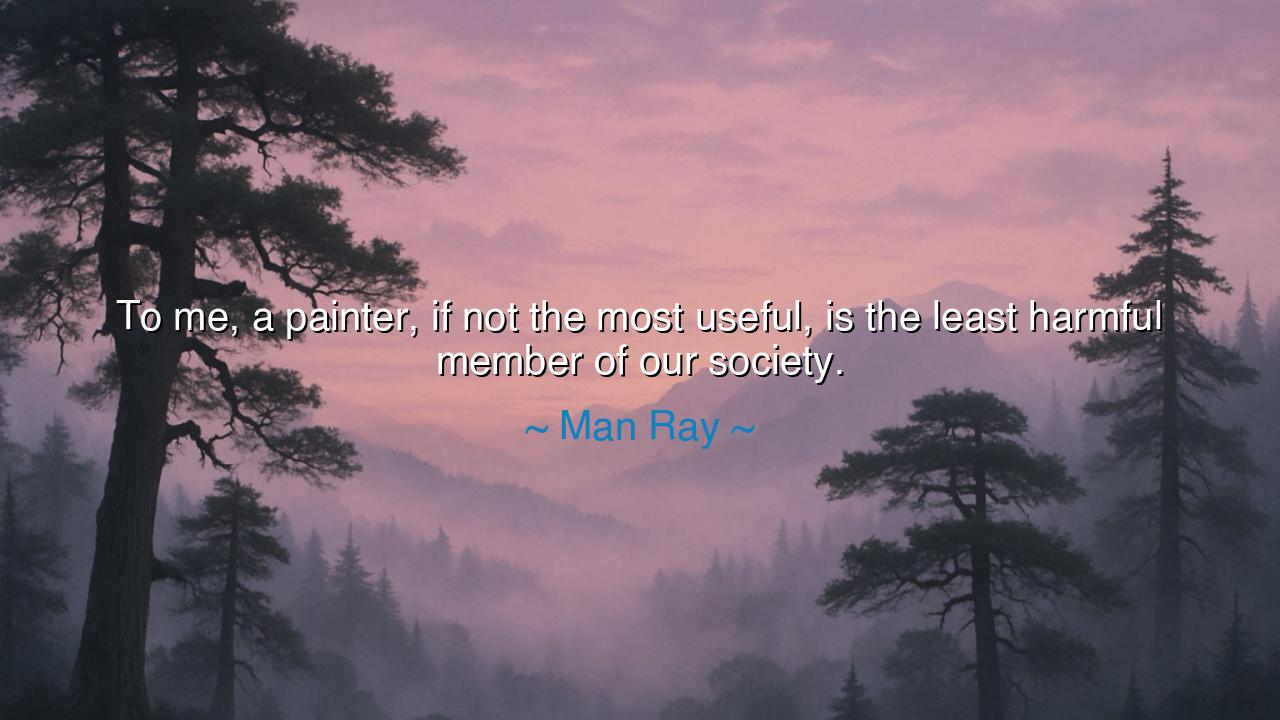
To me, a painter, if not the most useful, is the least harmful






Hear the voice of Man Ray, the restless spirit of Dada and Surrealism, who once declared: “To me, a painter, if not the most useful, is the least harmful member of our society.” These words, at first spoken with irony, conceal a profound truth. For in them lies the paradox of art itself: that it may not till the fields, nor build the bridges, nor draft the laws, and yet it wounds no one, and its gifts, though subtle, shape the soul of a people.
The painter, in Man Ray’s eyes, is not measured by the same scales as the soldier, the merchant, or the politician. The soldier defends, yet also destroys. The merchant provides, yet may exploit. The politician leads, yet often deceives. The painter, by contrast, harms no one; his weapon is color, his battlefield is canvas, his legacy is vision. He may not bring bread to the table, but he brings meaning to the hunger, and this too is a form of sustenance. To live without bread is death of the body; to live without beauty is death of the spirit.
Consider the time of Vincent van Gogh, who sold almost nothing in his lifetime, who was mocked, ignored, and cast aside as mad. By the standards of “usefulness,” he was worth little to his society. Yet who today can deny the wealth he has given to humanity? His sunflowers still burn with light, his starry nights still stir hearts across the world. In his day, he was not useful; yet neither was he harmful. And in the centuries that followed, his art proved more enduring, more healing, than the weapons forged by kings or the decrees written by ministers.
Man Ray himself was no stranger to this struggle. As an artist of the avant-garde, he dismantled conventions, turned objects into visions, and challenged society to see differently. Many saw this as folly, but in truth, it was a gift. For while the world was torn apart by war, ideology, and greed, the artist’s rebellion harmed no one; it instead offered liberation for the imagination. The painter, the dreamer, becomes a keeper of innocence in a world of corruption, a guardian of vision in a world enslaved by utility.
Let us then reflect on what it means to be “useful.” Is a man useful only if he increases wealth? Is a woman useful only if she produces? By such measures, we may exalt the profiteer and scorn the philosopher, reward the destroyer and ignore the healer. But if usefulness is measured by the depth of a gift to the human spirit, then the artist is among the greatest benefactors of all. He offers no harm, only mirrors for truth, windows for wonder, and pathways for the soul to walk beyond the limits of the visible.
The lesson here is not only for the artist, but for all. In a world where men seek power and wealth, and in their striving leave scars upon the earth and upon each other, let there always be some who, if not the most useful, are the least harmful. Let there be those whose work heals rather than wounds, whose craft brings joy rather than fear. And let us not forget to honor them, for though their hands may not build our towers, they build our spirits, and without that, the towers fall empty.
Therefore, O listener, take practical action: support the arts in your community, encourage the makers of beauty, defend the dreamers against neglect. And in your own life, seek to be “least harmful”—to live in such a way that your presence leaves behind no wounds, but instead a legacy of gentleness, kindness, and creation. For the greatest societies are not only those that build weapons or wealth, but those that leave behind works of wonder for generations yet unborn.
And so the teaching endures: the painter, the poet, the dreamer may not feed the body, but they nourish the eternal soul. They may not be crowned the most useful, but in being the least harmful, they preserve the fragile flame of humanity itself. This is the wisdom of Man Ray, and it is a torch for us all.






AAdministratorAdministrator
Welcome, honored guests. Please leave a comment, we will respond soon